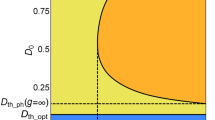Summary
Theoretical and experimental results are reported, obtained with a solid-state laser consisting of many active elements in series. A statistical treatment is developed to derive the oscillation conditions. Asymptotic expressions are given of the threshold gain per unit length holding either for a very large number of elements or for inner surface reflectivities close to 1. It turns out that lossless reflections at the inner surfaces can increase the cavityQ with respect to a one-element laser of the same active length. Preliminary experiments with five and tenelement lasers demonstrate the mode selection property of the manyelement laser and show the tendency of the system to a «quasicontinuous» emission. The possibility of obtaining some optical correction of the defects inherent in the solid material has also been demonstrated.
Riassunto
Si descrivono i risultati sia teorici che sperimentali, ottenuti con un laser allo stato solido composto da più elementi attivi in serie. Per ricavare le condizioni di oscillazione è stato usato un trattamento statistico. Si danno delle espressioni asintotiche per il guadagno per unità di lunghezza alla soglia, che valgono o quando il numero degli elementi è molto grande, o quando la riflettivita delle superficie interne tende a 1. Risulta che riflessioni senza perdite alle superficie interne possono aumentare ilQ della cavita rispetto a un laser composto da un solo elemento avente la stessa lunghezza di materiale attivo. Risultati sperimentali preliminari su laser composti da cinque o dieci elementi dimostrano che laser a più elementi possono essere utilmente impiegati per la selezione dei modi. Si mostra inoltre che tali sistemi tendono all’emissione «quasi continua». Un altro vantaggio dei laser a più elementi attivi, rispetto a quelli composti da un unico elemento, è la possibilità di correggere in maniera semplice i difetti ottici del materiale solido.
Similar content being viewed by others
References
D. A. Kleinman andP. P. Kisliuk:Bell System Techn. Journ.,41, 453 (1962).
H. K. V. Lotsch: Scientific Report No. 2, Contract No. AF 19(604)-8052, Quantum Electronics Lab., Caltech (1962).
T. R. Koehler: I.B.M. Research Paper RJ-260 (1963).
H. Kogelnik andC. K. N. Patel:Proc. IRE,50, 2365 (1962).
S. A. Collins andG. R. White:Appl. Opt.,2, 448 (1963).
M. Birnbaum andT. L. Stocker:Journ. Appl. Phys.,34, 3414 (1963).
J. A. Fleck jr.:Journ. Appl. Phys.,34, 2997 (1963).
G. Toraldo di Francia:La Diffrazione della Luce (Torino, 1958), p. 406.
Tables of Chebyshev Polynomials S n (x) and C n (x), National Bureau of Standards (Washington D. C., 1952), p. v–xxix.
M. Hercher:Appl. Opt.,1, 665 (1962).
M. Hercher:O.S.A. Fall Meeting (Rochester, N. Y., 1962).
G. Toraldo di Francia:Optical Image Evaluation, National Bureau of Standards (Washington, 1951).
H. Statz andG. de Mars:Quantum Electronics (New York, 1960), p. 530.
H. Statz,C. Luck,C. Shafer andM. Ciftan:Advances in Quantum Electronics (New York, 1961), p. 342.
H. Statz, C. L. Tang andG. de Mars:Bull. Am. Phys. Soc., II,8, 87 (1963).
K. Gürs:Zeits. Naturforschg.,17 a, 990 (1962).
K. Gürs:Zeits. Naturforschg.,18 a, 510 (1963).
K. Shimoda:Proc. Symposium on Optical Masers (New York, 1963), p. 95.
Author information
Authors and Affiliations
Additional information
The present research has been sponsored in part by Electronics Research Directorate, AFCRL United States Air Force, monitored by the European Office, Office of Aerospace Research, under a Contract with Centro Microonde.
Rights and permissions
About this article
Cite this article
Pratesi, R., Di Francia, G.T. & Ronchi, L. Many-element lasers. Nuovo Cim 34, 40–50 (1964). https://doi.org/10.1007/BF02725867
Received:
Published:
Issue Date:
DOI: https://doi.org/10.1007/BF02725867




